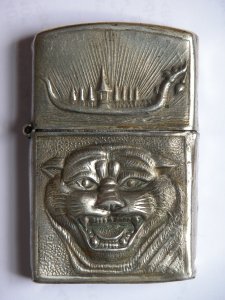Hand Engraved
The
Vietnamese engraver, a regular of girlie bars,
would have a stand at the corner of the room.
A device like a dentist tool and an old GMC
battery constituted his improvised workshop.
The soldier chose from a catalogue the text
and the design that was the most appropriate
according to his feeling or state of mind.
In a few minutes, the engraver did a bad quality
job for only 25 cents by hand on the face.
The quality depended on how steady his hand
was and how good an eye the engraver possessed.
In this category there are nice engraved lighters
but the majority is bad. It is also this kind
of engraving actually done in some workshops
in South Vietnam where young ladies, around
the clock, engrave stainless steel lighters
from China.

Hand
engraved
The
P.X. in Saigon had real Zippo's. They were
sold in the P.X with unit markings and names
but no sex, slang, drunk or drug engravings
on them. These were all done by hand in the
villages near the U.S bases.
Machine Engraved
The
Vietnamese craftsmen operate in the vicinity
of the military bases in Vietnam. The mechanical
process was done with a pantograph mounted
on a working table whose top part was constituted
by a vice to tighten the lighter and a template
support. Those templates were made of brass
or wood, the size was superior to definitive
engraving. A finger connected to the pantograph
followed the template contours and the tool
at the top of the pantograph engraved the
lighter. It was possible to engrave the same
pattern at different scales. The texts were
composed letter by letter or if chosen from
the catalogue, already attached into the template.
There were probably 200 different designs
and more than hundred texts.


Engraving
done with the pentograph at the mini position
The engravers had many of the same templates
that were sold to them by the Hermes engraving
folks (Vietnam distributors). A color plate
with snoopy on his doghouse, the cyclo all
the US insignia and many naked women was proposed
to choose the correct design.
The most popular seems to be " Yeah though
I walk through the valley..." whom an
extremely rare variant exist " Yeah though
I fly through the valley..." It is a
take off of the 23rd Psalm.
The next most popular is Freedom, "For
those who fought for it freedom..." along
with a few others like " When I die bury
me face down…." and the famous "Death
is our Business and Business has been good".
If you were out in the jungle you could see
that particular saying on soldier's helmet.


Pantograph
machine used during the war and color plate
supplied by Hermes Cie.
The
engraving looks like as if done by hand because
the machine had a lot of clearance and templates
were used. It is the kind of engraving on
totally counterfeit zippos than you can buy
today in Saigon (sidewalk vendors).
Engraved zippos in other countries
Soldiers
spent their days off (R & R) on the beach
of China Beach or Vung Tau but sometimes went
to Thailand, Philippine or Japan. The P.X.
was effective in American bases of Japan and
Philippines and Japanese artist engraved Zippos.
Mainly sterling silver decorated with tigers
or dragons, but also some authentic Zippos
with Vietnam War poetry engraved on it. Of
course they are very good quality copies and
impossible to detect because the lighters
and dates are correct and the job was commissioned
by soldiers.

Sterling
Silver lighter engraved in Japan
The
jewellers from Bangkok often did silver lighters
for a major command. These lighters were made
from an embossed sterling silver sheet decorated
with tigers, elephants but also with army
insignia. On the back of the lighter there
is the jeweller's address.


Thailand
Sterling Silver lighter bring home as souvenir
The Japanese
industry built Vulcan or Penguin windproof
lighters and acid etched the design of the
American or Australian war ships. Those lighters
were made on a minimum special order of 100
and only for one dollar each including shipping.


Penguin
lighter at the left and Zippo lighter
Germany
Engraved


Between
1963 and 1975 a German engraver has done this
engraving for US occupation troops. It is
the continuation of Viet-Nam tradition. If
you have this kind of lighter, I will be happy
if you could send me a picture.
Cut
away Chimneys
The authentic
lighters sometimes their chimney cut away.
Those cuts were done to light the opium pipes
easily. During the last years of the war,
many American GI's became bored at the lack
of "Action" and turned to drug to
relieve the boredom.
Disabused
by too much horror, too many comrades injured
or killed in frightful conditions, destabilized
in their judgement by this war that they refused
many turned to alcohol or drug.
What
will be the future? Are they going to leave
this country alive?
Some
others, rocked by Jimi Hendrix music , used
their lighters to warm heroine dose.


Two
lighters with cut chimney
Stik ons Zippos
A
Zippo that has a Vietnam emblem is the easiest
counterfeit to fabricate. As the WWII, genuine
Vietnam Zippos with stick on exist. In addition
to the insignias proposed by Zippo Bradford
on his catalogue, soldiers have glued on their
lighters unit, boat and military insignias.
It is in this category that you found more
counterfeit Zippos. It is easier to weld an
insignia than to draw a design without pantograph.
The lighter are often distressed by blowlamp
to mask the welding process. The emblem will
protect the case finish directly around its
perimeter, so a used lighter will tend to
have a zone of unblemished chrome around the
emblem. This old patina need time so the Vietnamese
have no time and distress the lighter.



Genuine
101st Airborn Zippo, the lighters at the right
are newly distressed
Continue >>
![[]](http://m3.moostik.net/img/?pseudo=bobzippo&option=invisible)